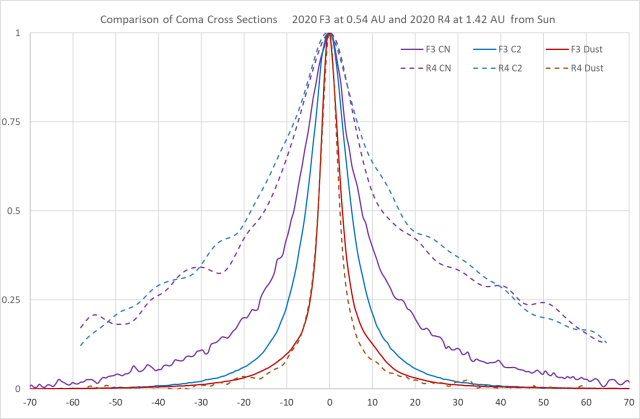- This topic has 6 replies, 3 voices, and was last updated 3 years, 10 months ago by
 Nick James.
Nick James.
-
AuthorPosts
-
31 January 2022 at 2:00 pm #575148
 Robin LeadbeaterParticipant
Robin LeadbeaterParticipantWhen measuring the distribution of different components in cross sections through the coma, I noticed that while the distributions of CN and C2 in 2020 R4 were similar, in 2020 F3, the C2 distribution was significantly narrower than for CN. A recent article in COBS provided a possible answer. C2 is broken down by the UV in sunlight and the rate at which this happens accelerates closer to the Sun. (The 2020 F3 measurement was when the comet was 0.43AU from the Sun compared with 1.42AU for 2020 R4).
When the distributions are over-plotted on the same scale however, it is clear that while the dust distribution is almost identical in both comets, both the CN and C2 distributions are more compact for the 2020 F3 measurement compared with that for 2020 R4. Is CN also broken down by sunlight, though at perhaps a slower rate than C2 or do I need to keep searching for other explanations ?

X scale x1000 km
Attachments:
31 January 2022 at 2:12 pm #585190 Robin LeadbeaterParticipant
Robin LeadbeaterParticipant“Is CN also broken down by sunlight, though at perhaps a slower rate than C2 ?”
Actually, answering my own question it looks like that cannot be the explanation as CN is seen widely distributed in the cross section through the tail of 2020 F3. Any ideas of what is going on?
4 February 2022 at 12:33 pm #585201 Maxim UsatovParticipant
Maxim UsatovParticipantRobin, I wonder if this is due to the Swings effect and the varying g-factor producing different fluorescence intensities. Looks like the ratios in your data are within the range for CN. Please see attached two relevant pages from the book “Comets” by J. A. Fernandez.
4 February 2022 at 3:33 pm #585202 Robin LeadbeaterParticipant
Robin LeadbeaterParticipantHi Maxim,
Thanks for the reference. ( I am on a steep learning curve here !) I can understand how the Swings effect could enhance or suppress the strength of the resonance emission due to the velocity relative to the sun (The distributions are normalised relative to the intensity at the coma centre so don’t show the absolute strengths) but I don’t follow how that could alter the shape of the CN distribution. Would this be due to the resulting radiation pressure sweeping the CN away from the coma into the tail, like Sodium in 2020 F3 ?
That reference to parent molecules and the Haser model on your Fernandez page 68 did remind me of some comments from Jeff Morgenthaler of the IoIO team on my F3 cross sections.
“CN is produced from a parent molecule, likely HCN. The combination of that double process ends up extending the lifetime of CN to photodissociation (destruction by sunlight). I have not done the conversion of angular scale to distance from the comet on your night of observation, but the characteristic scale length of CN emission when comets are at 1 AU from the sun tends to be about 20,000 km. C2 is a little weirder in terms of parent molecules. It seems to have two dominant ones, leading to a flat profile in the inner few thousand km of the coma. Then it drops off with a profile slightly shorter than CN.”
So perhaps I need to consider the effect of sunlight on both the rate of production and destruction of CN and C2 and follow up on the Haser model.
Thanks
Robin
6 February 2022 at 9:41 pm #585212 Nick JamesParticipant
Nick JamesParticipantThat’s a very interesting observation.
There is an entire chapter on this in Comets II (edited by Festou, Keller and Weaver) which describes the generation and distribution of species in the coma (pp 425 onwards). It was published in 2004 before much of the recent space-based observations of comets but it is an excellent reference book if you can get hold of a copy. I can see some second-hand around £60 online. The book is so massive that it is in imminent danger of collapsing under its own gravity. A more recent book, “An introduction to comets” by Nicolas Thomas is post-Rosetta and also covers this.
7 February 2022 at 1:54 am #585213 Robin LeadbeaterParticipant
Robin LeadbeaterParticipantThanks Nick,
I’ve found the original preprints of Comets II are available to download from the Lunar & Planetary Institute. Plenty of reading there !
7 February 2022 at 7:42 am #585214 Nick JamesParticipant
Nick JamesParticipantIsn’t the web wonderful? I like this statement at the top of that page: “Once the book has been published (anticipated publication date May 2005), the download option will be disabled, so authors should take advantage of the opportunity to download their chapters now”.
-
AuthorPosts
- You must be logged in to reply to this topic.
